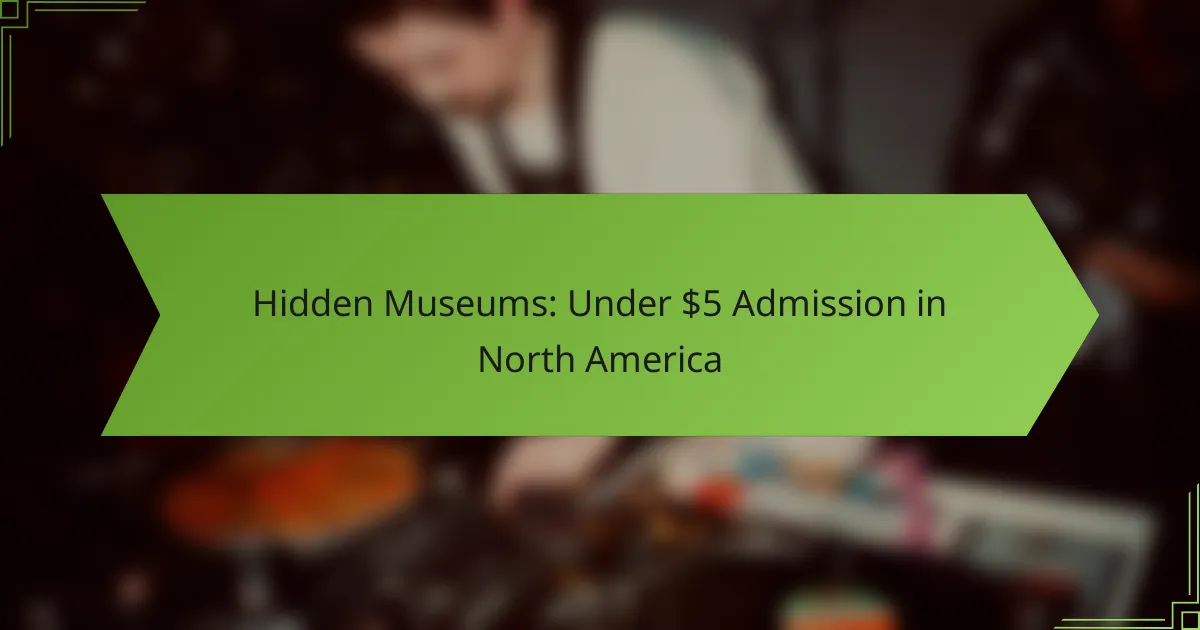Hidden museums provide an opportunity to explore unique cultural experiences at low costs, often highlighting niche topics that larger institutions may overlook. These intimate venues allow visitors to engage with art, history, and science in a more personal setting, making them a rewarding choice for enthusiasts seeking distinctive experiences.
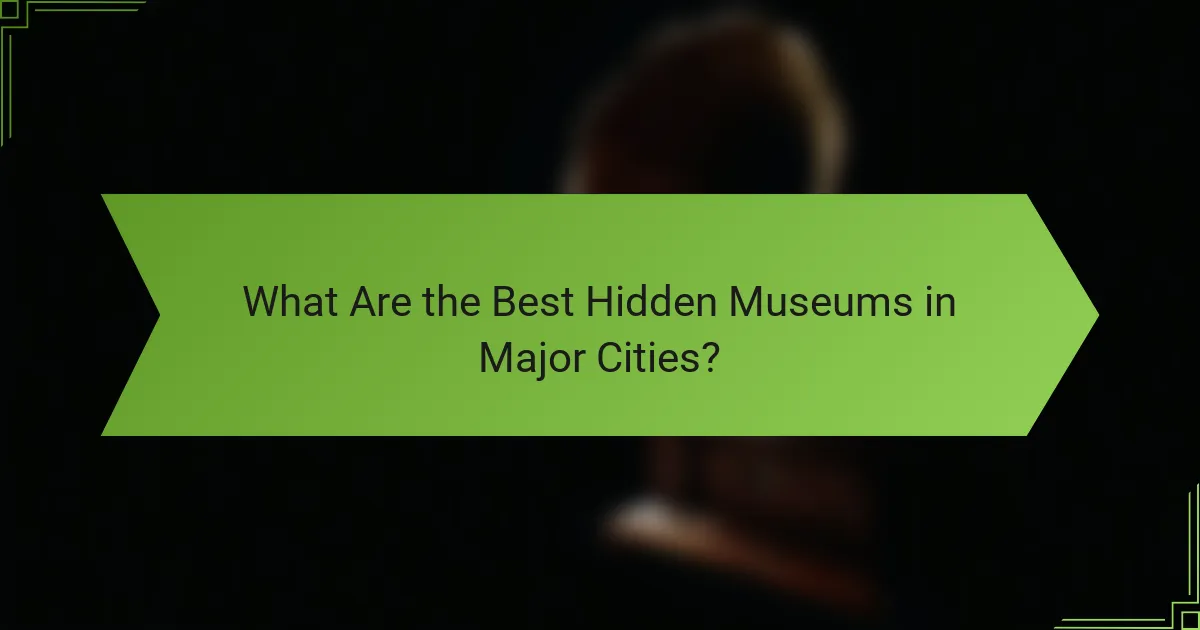
What Are the Best Hidden Museums in Major Cities?
Hidden museums offer unique cultural experiences at low costs, often showcasing niche topics that larger institutions overlook. These venues provide an intimate setting to explore art, history, and science in engaging ways.
New York City: The Tenement Museum
The Tenement Museum focuses on the immigrant experience in New York City, located in a restored tenement building on the Lower East Side. Visitors can take guided tours that highlight the stories of the families who lived there, making it a deeply personal and educational experience.
Tickets are reasonably priced, often around $30 for adults, with discounts available for students and seniors. It’s advisable to book in advance, as tours can fill up quickly, especially on weekends.
San Francisco: The Museum of Craft and Design
The Museum of Craft and Design showcases contemporary craft and design through rotating exhibitions. It emphasizes the intersection of art and functionality, featuring works from local and international artists.
Admission is typically around $10, making it an affordable option for those interested in innovative art forms. Check their calendar for special events and workshops that often accompany exhibitions, providing hands-on experiences.
Chicago: The International Museum of Surgical Science
This unique museum is dedicated to the history of surgery and medical instruments, housed in a historic mansion. It offers a fascinating look at the evolution of surgical practices and technology through exhibits and artifacts.
Admission costs about $20, with discounts for students and seniors. Plan your visit around their guided tours for a more in-depth understanding of the exhibits, which can enhance the overall experience.
Los Angeles: The Museum of Jurassic Technology
The Museum of Jurassic Technology presents a quirky blend of art, science, and history, often blurring the lines between fact and fiction. Its eclectic exhibits range from unusual artifacts to intricate dioramas, inviting curiosity and contemplation.
Entry fees are modest, generally around $8, making it accessible for all. Due to its unique nature, allow extra time to explore and appreciate the various installations, as they often require thoughtful engagement.

How Can You Find Low-Cost Cultural Events?
Finding low-cost cultural events is straightforward with the right resources. Community boards, social media groups, and event aggregator websites are excellent starting points to discover affordable activities and experiences in your area.
Local Community Boards
Local community boards often serve as a hub for information about cultural events. These boards can be found in libraries, community centers, and online platforms specific to your city or neighborhood.
Check regularly for postings about free or low-cost events such as art exhibitions, workshops, and performances. Many local organizations also post updates about special events that may not be widely advertised.
Social Media Groups
Social media groups dedicated to local culture and events are valuable resources for finding low-cost activities. Platforms like Facebook and Meetup host groups where members share information about upcoming events.
Join groups that focus on your interests, and keep an eye out for posts about free concerts, gallery openings, or community festivals. Engaging with group members can also lead to insider tips on hidden gems in your area.
Event Aggregator Websites
Event aggregator websites compile listings of cultural events from various sources, making them easy to browse. Websites like Eventbrite, Meetup, and local tourism sites often feature sections for free or low-cost events.
Use filters to narrow down your search by price, location, and type of event. Subscribing to newsletters from these sites can also keep you informed about upcoming events that fit your budget.
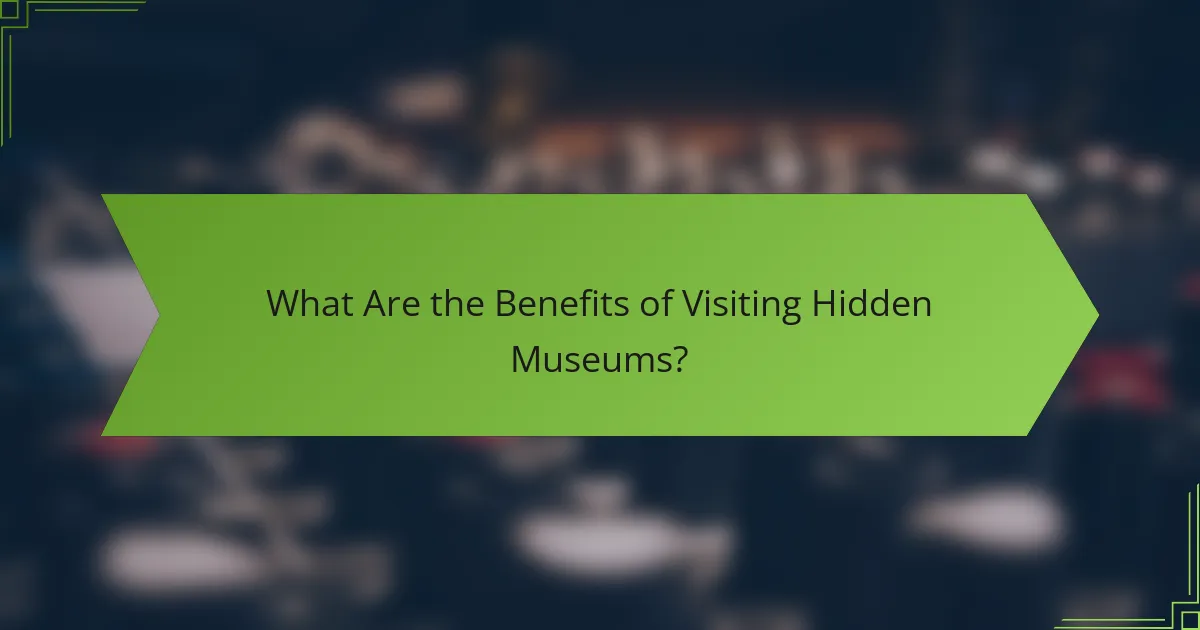
What Are the Benefits of Visiting Hidden Museums?
Visiting hidden museums offers unique advantages, including access to distinctive cultural experiences, less crowded environments, and often lower admission fees. These benefits make exploring lesser-known institutions a rewarding choice for art and history enthusiasts.
Unique Cultural Experiences
Hidden museums frequently showcase local art, history, and culture that larger institutions may overlook. This can include specialized exhibits that reflect the community’s heritage or unique artistic expressions that are not found elsewhere.
For example, a small museum dedicated to local folklore might feature artifacts and stories that provide deeper insights into the region’s traditions. Engaging with these unique narratives can enhance your understanding of the area and its people.
Less Crowded Environments
One of the most appealing aspects of hidden museums is their typically lower visitor numbers. This allows for a more intimate experience, where you can explore exhibits at your own pace without the pressure of large crowds.
In many cases, you can interact more closely with staff or volunteers, who are often passionate about sharing their knowledge. This personal touch can enrich your visit and provide a deeper appreciation for the exhibits.
Affordable Admission Fees
Hidden museums often have lower admission fees compared to larger, well-known institutions. Many charge nominal fees or even operate on a donation basis, making cultural experiences accessible to a wider audience.
For instance, you might find admission fees ranging from a few dollars to free, allowing you to enjoy art and history without financial strain. This affordability encourages more frequent visits and supports local cultural initiatives.
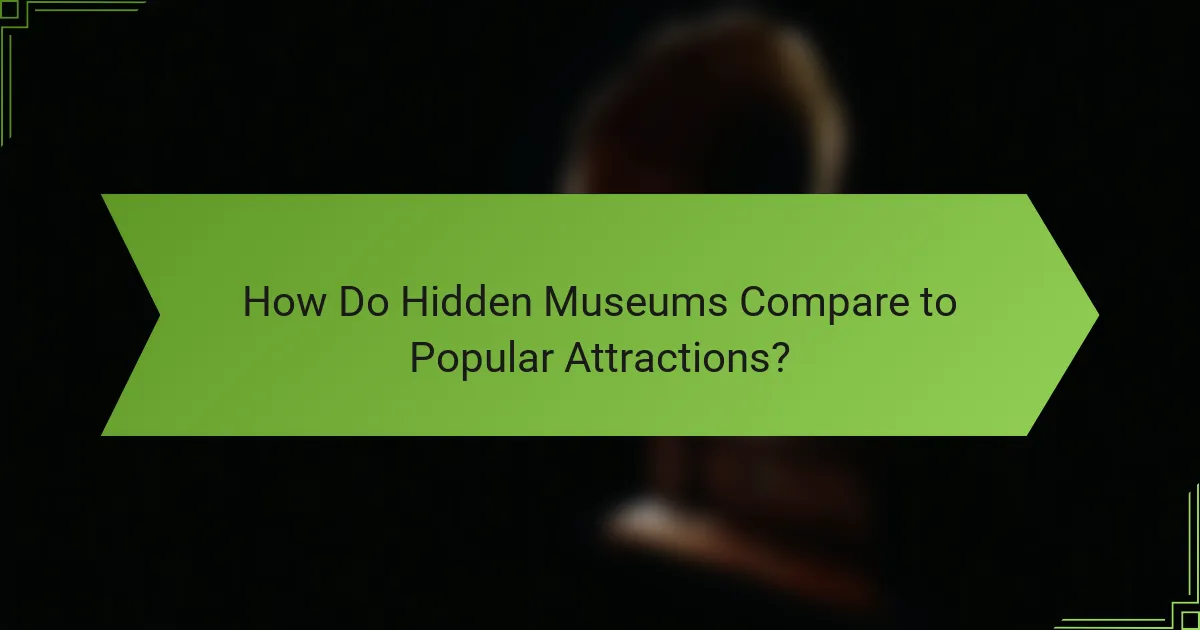
How Do Hidden Museums Compare to Popular Attractions?
Hidden museums often provide a more intimate and unique experience compared to popular attractions, which tend to draw larger crowds. While mainstream sites focus on broad appeal, hidden gems offer specialized insights and a quieter atmosphere, making them ideal for those seeking a deeper cultural engagement.
Intimacy vs. Mass Appeal
Hidden museums typically foster a sense of intimacy, allowing visitors to engage more personally with exhibits and staff. This contrasts sharply with popular attractions, where the experience can feel rushed and impersonal due to large crowds.
For example, a small art gallery may host local artists and provide opportunities for direct interaction, whereas a major museum might feature blockbuster exhibitions that attract thousands daily. This difference can significantly enhance the visitor’s connection to the art and culture presented.
Cost Differences
Visiting hidden museums often comes with lower admission fees compared to well-known attractions, which can charge premium prices. Many hidden gems operate on a donation basis or have nominal entry fees, making them accessible to a wider audience.
For instance, while a popular museum might charge around $25 for entry, a lesser-known museum could ask for a few dollars or even nothing at all. This affordability allows visitors to explore multiple venues without breaking the bank.
Focus on Niche Topics
Hidden museums frequently specialize in niche topics that may not be covered by larger institutions. This focus allows them to present unique collections that cater to specific interests, such as local history, obscure art forms, or specialized scientific fields.
For example, a hidden museum dedicated to the history of a particular neighborhood may showcase artifacts and stories that larger museums overlook. This specialized focus can provide a richer and more informative experience for visitors interested in those topics.
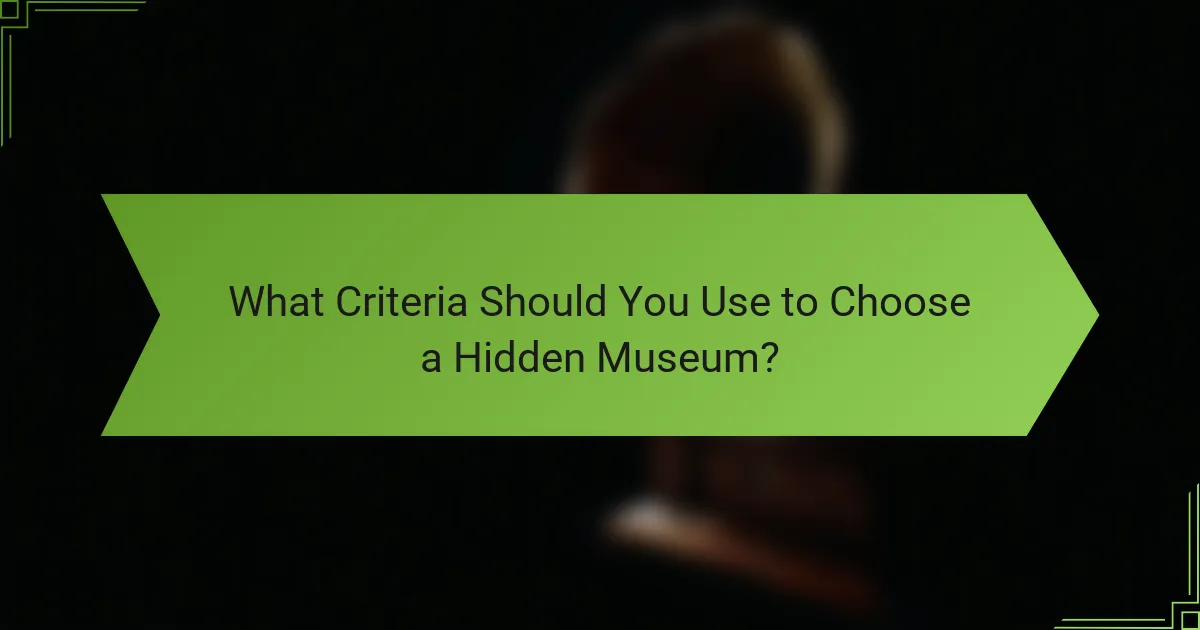
What Criteria Should You Use to Choose a Hidden Museum?
When selecting a hidden museum, consider factors such as location accessibility, exhibit relevance, and visitor reviews. These criteria help ensure a rewarding experience that aligns with your interests and logistical needs.
Location Accessibility
Location accessibility is crucial for a convenient visit to a hidden museum. Check if the museum is easily reachable by public transport or if parking is available nearby. Aim for places that are within a short travel distance, ideally under an hour from your location.
Consider the surrounding area as well; neighborhoods with amenities like cafes or shops can enhance your visit. For example, a museum located in a vibrant district may offer additional cultural experiences, making your trip more enjoyable.
Exhibit Relevance
Exhibit relevance refers to how well the museum’s collections align with your interests. Research the types of exhibits offered and see if they cover topics that intrigue you, such as local history, art, or science. Museums that focus on niche subjects often provide unique insights and experiences.
Look for special events or temporary exhibitions that might appeal to you. Many hidden museums host rotating displays, which can provide fresh perspectives and make repeat visits worthwhile.
Visitor Reviews
Visitor reviews can offer valuable insights into the quality of a hidden museum. Check online platforms for feedback regarding the overall experience, including the friendliness of staff, cleanliness, and the depth of information provided. Look for patterns in reviews to gauge whether the museum consistently meets visitor expectations.
Pay attention to comments about specific exhibits or features. Positive reviews highlighting unique aspects or engaging activities can help you decide if a museum is worth your time and investment. Aim for places that have a solid rating, ideally above four stars on review sites.

What Are Some Upcoming Low-Cost Cultural Events?
Low-cost cultural events are a great way to explore art, history, and community without spending much. These events often include museum exhibitions, local festivals, and workshops that are either free or have a minimal entry fee.
Art Exhibitions
Many galleries and museums host rotating exhibitions that feature local artists or historical collections at little to no cost. Check local listings for openings, as many venues offer free admission on specific days or during special events.
For example, some cities have “First Friday” events where galleries open their doors for free, allowing visitors to enjoy art and meet artists. Look for similar initiatives in your area to take advantage of these opportunities.
Community Festivals
Community festivals often celebrate local culture through music, food, and art, and they typically have low or no admission fees. These events provide a chance to engage with the local community and experience cultural traditions.
Keep an eye on local event calendars for seasonal festivals, which may include craft fairs, cultural parades, or food festivals. Participating in these events can enhance your understanding of local heritage while enjoying affordable entertainment.
Workshops and Classes
Many cultural institutions offer workshops and classes at low costs, focusing on various arts such as painting, pottery, or dance. These sessions are often led by experienced instructors and provide hands-on experience.
Look for community centers or local art schools that may offer subsidized classes. These can be a great way to learn new skills while connecting with others who share similar interests.

